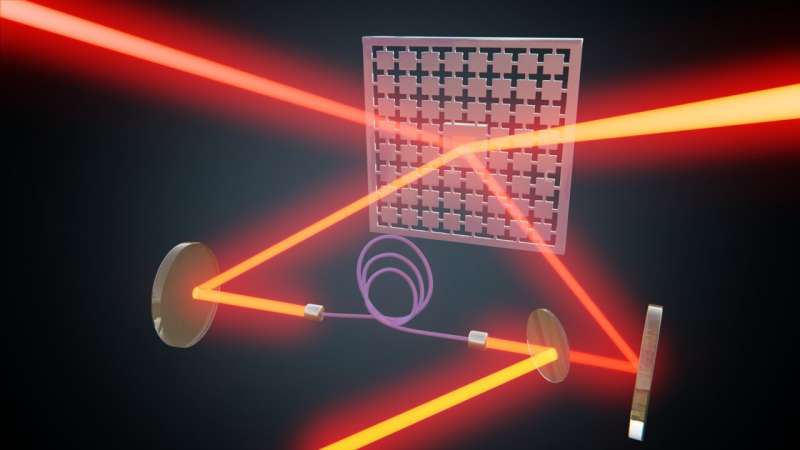This article has been reviewed according to Science X's editorial process and policies. Editors have highlighted the following attributes while ensuring the content's credibility:
fact-checked
peer-reviewed publication
trusted source
proofread
Researchers report on a new technique for cooling membranes with lasers

Using a new technique, researchers at the University of Basel have succeeded in cooling a small membrane down to temperatures close to absolute zero using only laser light. Such extremely cooled membranes could, for instance, find applications in highly sensitive sensors.
As far back as 400 years ago, the German astronomer Johannes Kepler came up with the idea of solar sails that could be used by ships to sail through the universe. He suspected that light exerted a force when reflected by an object. This concept also allowed him to explain why the tails of comets point away from the sun.
Nowadays, scientists use the light force, among other things, to slow down and cool atoms and other particles. Typically, one needs a complex apparatus to do this. A team of researchers at the University of Basel, led by Prof. Dr. Philipp Treutlein and Prof. Dr. Patrick Potts, have now succeeded in cooling a wafer-thin membrane down to a temperature close to the absolute zero of minus 273.15 degrees Celsius using nothing but laser light. They recently published their results in the journal Physical Review X.
Feedback without measurement
"What makes our method special is that we achieve this cooling effect without making any kind of measurement," says physicist Maryse Ernzer, a Ph.D. student and first author of the research paper. According to the laws of quantum mechanics, a measurement, as is typically required in a feedback loop, leads to a change of the quantum state and hence to disturbances.
To avoid that, the Basel scientists developed a so-called coherent feedback loop in which the laser light acts both as a sensor and as a damper. In this way they dampened and cooled the thermal vibrations of a membrane made of silicon nitrate around half a millimeter in size.
In their experiment, the researchers directed a laser beam onto the membrane and fed the light reflected by the membrane into a fiber optic cable. In that process, the vibrations of the membrane caused small changes in the oscillation phase of the reflected light. The information on the instantaneous motional state of the membrane contained in that oscillation phase was then used, with a time delay, to apply just the right amount of force on the membrane at the right moment with the same laser light.
"That's a bit like slowing down a swing by briefly touching the ground with one's feet at the right time," Ernzer explains. To achieve the optimal delay of around 100 nanoseconds, the researchers used a 30-meter-long fiber optic cable.
Close to absolute zero
"Professor Potts and his collaborators developed a theoretical description of the new technique and calculated the settings for which we could expect to achieve the lowest temperatures; that was then confirmed by the experiment," says Dr. Manel Bosch Aguilera, who contributed to the study as a postdoc. He and his colleagues were able to cool the membrane down to 480 micro-Kelvin—less than a thousandth of a degree above the absolute zero of temperature.
In a next step, the researchers want to improve their experiment to the point that the membrane reaches the lowest possible temperature—the quantum mechanical ground state of the membrane's oscillations, that is. After that, it should also be possible to create so-called squeezed states of the membrane. Such states are particularly interesting for building sensors as they allow for a higher measurement accuracy. Possible applications of such sensors include atomic force microscopes, which are used to scan surfaces with nanometer resolution.
More information: Maryse Ernzer et al, Optical Coherent Feedback Control of a Mechanical Oscillator, Physical Review X (2023). DOI: 10.1103/PhysRevX.13.021023
Journal information: Physical Review X
Provided by University of Basel




















